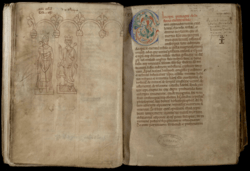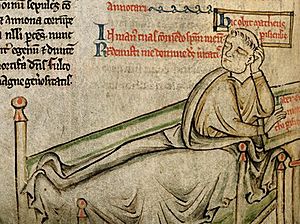Liber Eliensis facts for kids
Quick facts for kids Liber Eliensis |
|
|---|---|

Trinity College, Cambridge MS O.2.1
|
|
| Also known as | Book of Ely Historia Eliensis |
| Author(s) | Unknown |
| Ascribed to | Thomas or Richard, monks of Ely |
| Language | Medieval Latin |
| Date | Early through second-quarter 12th century |
| Provenance | Ely Abbey |
| Manuscript(s) | Trinity College, Cambridge MS O.2.1 (E) Ely Cathedral Chapter (F) British Library MS Cotton Titus A.i (G) British Library Cotton Domitian MS A.xv (B) British Library MS Cotton Vespasian A.xix (A) |
| Genre | Chronicle |
| Subject | Account of the history of Ely Abbey and the Bishopric of Ely |
| Sources | Æthelwold of Winchester's Libellus Bede's Ecclesiastical History of the English People Florence of Worcester's Chronicon ex chronicis among others |
The Liber Eliensis (say: LEE-ber EEL-ee-EN-sis) is an old history book from the 1100s. It was written in Latin by monks at Ely Abbey in England. This abbey was on an island called Ely in a marshy area known as The Fens. In 1109, Ely Abbey became a big church called a cathedral and the center of a new church region called a bishopric.
This book tells the story of Ely Abbey from when it was founded in 673. It also covers events up to the mid-1100s. The Liber Eliensis includes old documents and stories about saints. It's a great example of a local history book from that time. It even describes the chaos of a civil war called the Anarchy during King Stephen's rule. The book also talks about Nigel, who was the Bishop of Ely, and his disagreements with King Stephen. Plus, it shares stories of miracles by the abbey's special saint, Æthelthryth, and details about land given to Ely.
Today, two full copies of the Liber Eliensis still exist, along with some partial copies. The Latin version was printed in 1962, and an English translation came out in 2005. This book is a very important source for understanding the history of Ely and the area around it during the Middle Ages.
Contents
Who Wrote the Liber Eliensis?

The Liber Eliensis was created at Ely Abbey. This abbey became Ely Cathedral in 1109. Historians believe the book was written in different stages. Some parts might have been started around 1109, and others continued later, possibly in the 1170s.
The book was likely written in three main parts. The first part began after 1131. The second part, which talks about events up to 1154, explains that it was delayed. The final part was finished between 1169 and 1174. It mentions the death of Bishop Nigel, but not his replacement. This suggests it was completed before a new bishop took over.
People traditionally thought two monks named Thomas or Richard wrote the book. Many historians believe Richard, who was a leader at Ely Abbey, might be the author. However, no one is completely sure. The book itself says it was written because some monks at Ely wanted it to be.
The Liber Eliensis is one of many history books written by monasteries in the 1100s. These books told the stories of their religious homes and local areas. Books from southern England, like the Liber, often focused on arguments and problems involving their monasteries.
What's Inside the Book?

The Liber Eliensis is divided into three parts, called books.
Book One: Early History
The first book starts with a welcome and an introduction. It tells the story of how Ely Abbey was founded by a woman named Æthelthryth. It also covers the abbey's history and its leaders until the Danish invasions in the 800s. The book describes how the Danes destroyed the abbey. It ends with the rule of King Edgar (who ruled from 959 to 975).
Book Two: Abbey's Revival and Leaders
The second book begins with the abbey being rebuilt during King Edgar's time. It talks about the abbots (leaders) who followed, all the way to the last abbot, Richard. This book also includes many important documents and official papers.
Book Three: Becoming a Bishopric
The final book, Book Three, explains how the abbey became a bishopric (a region led by a bishop). It tells about the first few bishops. It even mentions the death of Thomas Becket, a famous archbishop. This book also has many documents about the bishops.
Life During the Anarchy
The book also shows how terrible the Anarchy was. This was a time of civil war during King Stephen's reign. The writer says that crops failed and people stole things, causing a terrible famine. The book describes the area around the abbey as being full of dead bodies. It also says that the price of grain became very high.
The Liber gives a lot of detail about Nigel of Ely's arguments with King Stephen. It even talks about the Battle of Lincoln, which wasn't directly about Ely. The book generally supports King Stephen over Bishop Nigel. When King Henry II became king, the Liber says it was a great event and praises the new king.
Miracles and Gifts
A big part of the book is about the miracles and fame of Ely's special saint, Æthelthryth. The beginning of the book includes an older "Life" story of Æthelthryth. This might have helped more people visit Ely as pilgrims. It also helped the monks explain why people had given gifts to the abbey in the past. Many gifts are described, like an altar cloth given by Queen Emma (who died in 1052). The miracle stories often say that people who wanted cures or miracles should come to the monastery and make a donation.
Land and Property
Another important topic in the book is how the abbey got its land. The Liber includes lists of the abbey's belongings. It records every gift of land, saying who gave it and sometimes details about their lives. This detailed record was useful if the abbey needed to defend its property. The monks used the Liber to argue that they, not the bishops, were the true owners of the abbey's rights and property after it became a bishopric. The book also records how property was divided between the monks and the new bishop. The writer says the monks barely got enough.
Important Burials
The book also highlights the many important people buried at Ely. This would have encouraged others to want to be buried there too. People would often give donations to the abbey to secure a burial spot. The Liber mentions the burials of bishops like Æthelstan and Ælfwine, and an archbishop named Wulfstan.
Why is the Liber Eliensis Important?

The Liber Eliensis was known by other writers in the Middle Ages. For example, Matthew Paris, a famous writer from the 1200s, used it as a source for his own history books. Another writer, Roger of Wendover, also knew about the Liber.
Some information in the Liber is very important for historians today. It's the first place that says Æthelwold translated the Benedictine Rule (a set of rules for monks) into Old English. The Liber is also the longest local history book written in England during the 1100s. It even describes the royal chancery, which was a government office. This might be the earliest proof that such an office existed in Anglo-Saxon England.
Historians use the Liber carefully because it was written to help Ely Abbey's claims. For example, it tried to show that the abbey had special rights, like being able to act like the king in its area. To do this, the book collected older documents. Some of these documents might have been changed or even faked to help the abbey. Even with these issues, the Liber Eliensis is still a valuable source for understanding the history of that time and the abbey itself.
Copies of the Book
Two full copies of the Liber Eliensis still exist. One is at Trinity College, Cambridge (called the E manuscript), and the other is at Ely Cathedral (called the F manuscript). The E manuscript is from the late 1100s, and the F manuscript is from the early 1200s. The F manuscript is the only book from the medieval monastery library that is still at Ely.
Several other copies contain only parts of the book. These include:
- British Library MS Cotton Titus A.i (G manuscript), which has part of Book II.
- British Library MS Cotton Domitian A.xv (B manuscript), which has Book I and parts of Book II.
- British Library MS Cotton Vespasian A.xix (A manuscript), which has parts of Book III.
It's complicated to figure out exactly how all these different copies relate to each other.
Published Versions
The full Latin text of Liber Eliensis was published in 1962. A complete English translation by Janet Fairweather was published in 2005. Before that, only parts of the book had been printed, without translations.
Images for kids
-
Trinity College, Cambridge MS O.2.1


